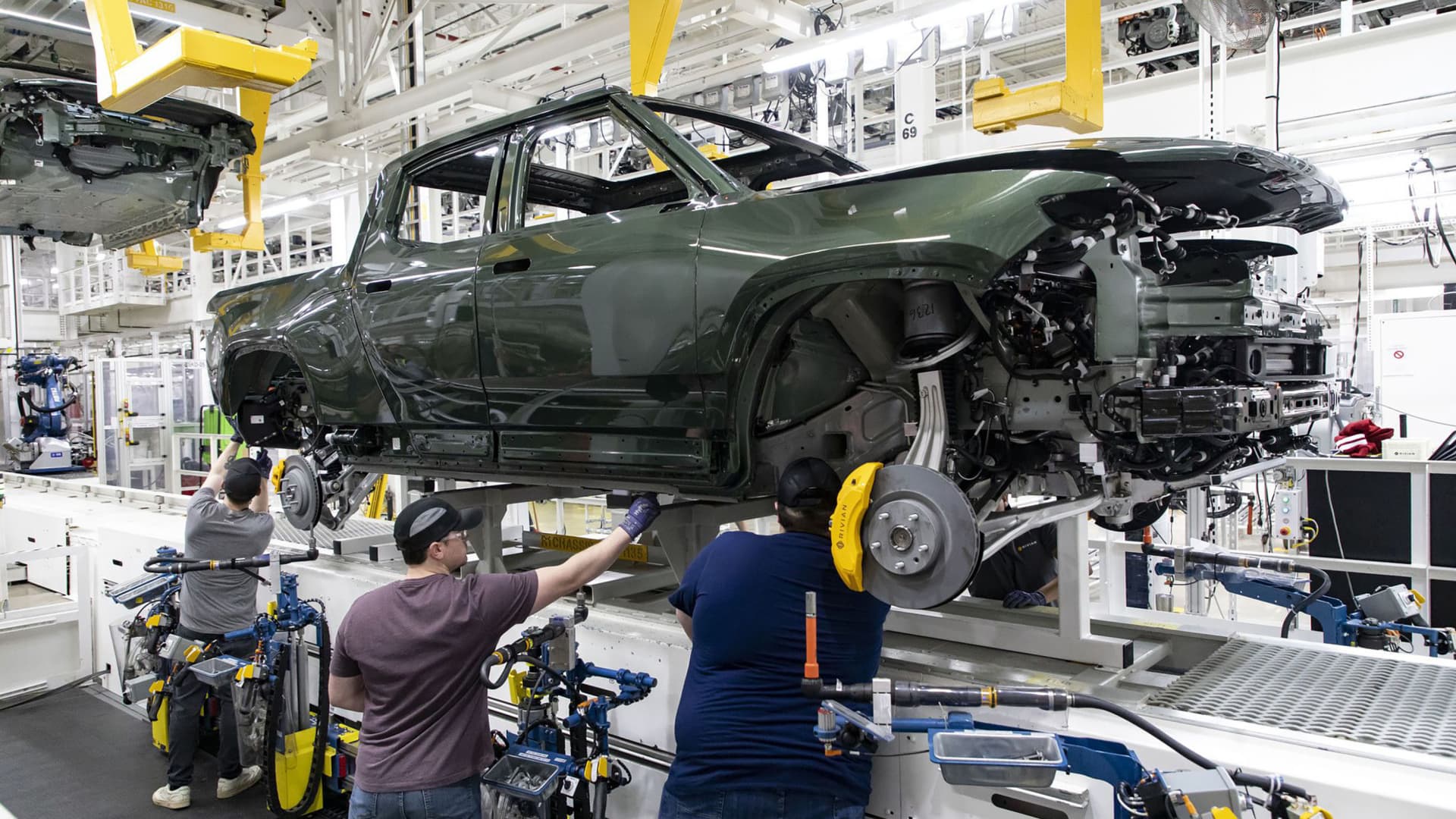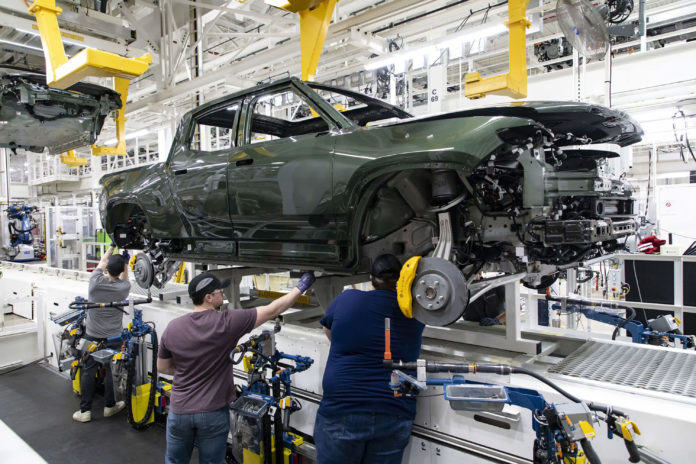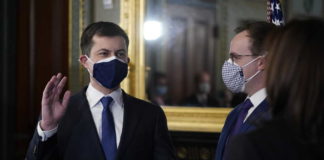
A Rivian R1T truck body lowered onto a chassis in the assembly line at the Rivian electric vehicle plant in Normal, Illinois. Georgia is giving the company $1.5 billion in subsidies to bring a new $5 billion EV plant to the southern state.
Brian Cassella | Tribune News Service | Getty Images
It is one of the few areas all parties seem to agree on: America’s domestic supply chain is broken. One of the main reasons is not in dispute either: an acute shortage of workers — 5.5 million more job openings than there are workers available to fill them, according to the Labor Department.
Those historic imbalances in the economy have turbocharged the competition between states for business and jobs. CNBC’s acclaimed America’s Top States for Business study is back for a 15th year to determine who is winning. We will reveal the full results, including scores and rankings for all 50 states, on July 13.
Our study scores the states in ten categories of competitiveness. Our tried-and-true methodology assigns a weight to each category based on how frequently states mention it in their economic development marketing. That way, we rate the states on the attributes they use to sell themselves.
War for workers
It should come as no surprise that in 2022, Workforce carries the most weight in the Top States for Business rankings. Practically every state mentions it, most multiple times.
“Ohio’s greatest asset is our workforce,” proclaims JobsOhio, that state’s economic development arm. “This workforce is educated, committed, skilled, and productive.”
The pitch helped the Buckeye State land one of the biggest economic development prizes in recent history: a $20 billion semiconductor facility being built outside Columbus by Intel.
Speaking with CNBC on the day of the announcement, Intel CEO Patrick Gelsinger cited “talent” as one of the main reasons the company chose Ohio.
“You know, we have all of the Midwest schools,” Gelsinger said, noting that The Ohio State University campus is just 20 miles from Intel’s site in New Albany. “We wanted a place that had a history; a passion for manufacturing at scale.”
Many experts believe worker shortages will be a long-term feature in the U.S. economy, not just because of the Great Resignation, but because of demographics.
“We see that population growth is at its lowest in history, and this is based on birth rates just not replacing themselves,” said Cara Christopher, senior vice president for business development at EMSI Burning Glass, an Idaho-based labor market consulting firm that provided some data on workforce attraction for the CNBC study. “Unfortunately, I think we’re going to continue to see a labor shortage. So, it’s really on employers and communities to think outside the box, finding dislocated workers.”
With that in mind, we have expanded our Workforce category for 2022. In addition to measuring things like college-level educational attainment, the concentration of technical workers, migration patterns and right-to-work laws, we are also looking at the availability of workers with two-year degrees and industry-recognized certifications.
“States really rely on people, and they rely on businesses for economic development,” Christopher said. “It’s really on states in partnership with many organizations within their walls to help address this and to really thrive.”
Infrastructure and the supply chain
The national effort to rebuild the supply chain takes more than people. Infrastructure is key, and it is the second most important category in this year’s rankings.
“When a business makes a decision to commit half a billion dollars or more in capital to a new facility, the infrastructure darn well better be in place — the roads, the bridges, the water, access to employees, the electrical components, redundancies within the system,” said Tom Stringer, managing director of the national site selection practice at BDO in New York.
The new emphasis on physical facilities comes after two years of focus on remote work because of the pandemic. Stringer said the supply chain crisis has changed everything.
“When there’s a hiccup in the system, everybody seems to catch the cold now,” Stringer said. “So, there is a big push now in manufacturing across the board.”
Our study looks at roads, bridges, ports and airports, access to major population centers, broadband, and utilities including the electrical grid. We also look at sustainability in the face of climate change.
Infrastructure has been an important consideration in a number of major corporate location decisions, particularly in the fast-growing electric vehicle sector. This includes Rivian, which is building a $5 billion assembly plant in Georgia, and Ford, which is teaming up with South Korean battery manufacturer SK Innovation to spend $11 billion on facilities in Kentucky and Tennessee.
Inflation and corporate subsidies
States are also helping companies make their decisions by offering generous incentives for companies to set up shop there. Ford stands to collect $500 million in incentives and enjoy nearly $400 million more in infrastructure improvements for its Tennessee investment, under a deal approved by the state last year. Rivian will receive $1.5 billion in state and local subsidies for its Georgia facility.
Not to be outdone, General Motors will pick up a billion in state subsidies to manufacture electric vehicles and batteries in its home state of Michigan.
Subsidy watchdog Greg LeRoy of the non-profit group Good Jobs First believes the state incentives for the electric vehicle industry in particular have gotten way out of hand.
“It’s pretty easy for states and governments to get caught up in the hype,” he said. “The downside risk is overspending.”
He said that when states are paying, in essence, hundreds of thousands of dollars in incentives per job, the cost-benefit analysis is out of whack.
“Will the average worker in this factory ever pay hundreds of thousands of dollars more in taxes than they consume in state and local public services, they and their family, over their working lifetime? The answer is no way,” he said. “Large, multinational, multistate companies are paying less in taxes, and everybody else is paying more.”
But Stringer, who worked on a number of electric vehicle deals, said states have been careful to build protections into their incentive packages.
“They’ve been performance based. So once the jobs are created, once the capital is expended, once the factory is built, then those incentives start to take hold,” he said.
Incentives are increasingly important in a time of record inflation, as companies seek to reduce their costs. They are among the things we measure in our Cost of Doing Business category, along with things like wages, utility costs, and rent.
Culture clash
In some states, traditional friendliness toward business is running headlong into raging culture wars. Florida Gov. Ron DeSantis sought to punish Disney for speaking out against the gender education law that critics call the “Don’t Say Gay” law. He pushed through a law to revoke the special tax district in Orlando that helped lure the company there in the 1960s.
But Disney spoke out only after employees criticized the company for its silence about the law. Many other companies have been critical of that and other laws that are seen as targeting various groups over cultural issues, complaining that the laws not only hurt their customers, they also limit their ability to attract and retain workers.
Walt Disney employees and demonstrators during a rally against the Florida “Don’t Say Gay” bill at Griffith Park in Glendale, California, U.S., on Tuesday, March 22, 2022.
Alisha Jucevic | Bloomberg | Getty Images
In 2022, our America’s Top States for Business study again considers Life, Health and Inclusion. We measure the inclusiveness of state laws, as well as other quality of life issues including crime rates, environmental quality, and health care — the pandemic is not over, after all.
And this year, for the first time, we consider the availability of child care, which U.S. Chamber of Commerce found is a “leading obstacle” to employees reentering the workforce.
Categories of competitiveness
Also on the scorecard: Technology and Innovation; Education, with a new emphasis on career education and community colleges; Access to Capital; and Cost of Living.
We are also paying attention this year to two emerging industries: cryptocurrencies and cannabis. Both help shape our Business Friendliness category, which also looks at each state’s legal and regulatory climates.
More CNBC features about state competitiveness are coming as we put the finishing touches on this year’s rankings. As always, we want to hear from you on social media, using the hashtag #TopStates.








